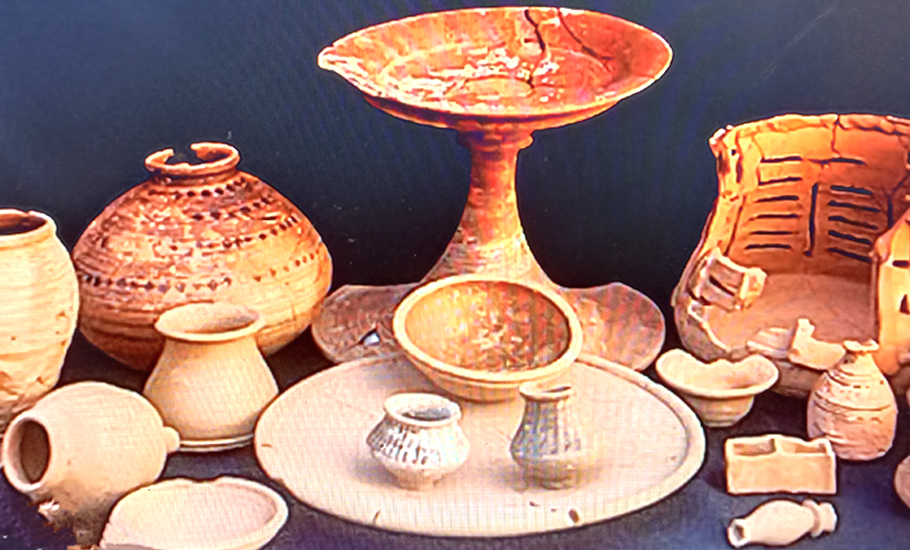
- Home
- News
- Analysis
- States
- Perspective
- Videos
- Education
- Entertainment
- Elections
- World Cup 2023
- Features
- Health
- Business
- Series
- Economy Series
- Earth Day
- Kashmir’s Frozen Turbulence
- India@75
- The legend of Ramjanmabhoomi
- Liberalisation@30
- How to tame a dragon
- Celebrating biodiversity
- Farm Matters
- 50 days of solitude
- Bringing Migrants Home
- Budget 2020
- Jharkhand Votes
- The Federal Investigates
- The Federal Impact
- Vanishing Sand
- Gandhi @ 150
- Andhra Today
- Field report
- Operation Gulmarg
- Pandemic @1 Mn in India
- The Federal Year-End
- The Zero Year
- Premium
- Science
- Brand studio
- Home
- NewsNews
- Analysis
- StatesStates
- PerspectivePerspective
- VideosVideos
- Entertainment
- ElectionsElections
- Sports
- Loading...
Sports - Features
- BusinessBusiness
- Premium
- Loading...
Premium

What was on the menu of people in the Indus Valley Civilization

There are approximately 140 Indus sites that have been excavated, but only 63 have been sampled for archaeobotanical remains the data on which has been published. Experts say that there has been a long history of archaeobotany (study of ancient plant remains) in the Indus Civilisation. Understanding this history is critical to understanding what Indus people ate. Some studies show barley,...
There are approximately 140 Indus sites that have been excavated, but only 63 have been sampled for archaeobotanical remains the data on which has been published. Experts say that there has been a long history of archaeobotany (study of ancient plant remains) in the Indus Civilisation. Understanding this history is critical to understanding what Indus people ate.
Some studies show barley, a winter crop, was popular in the early period of the Indus Valley Civilization (IVC), according to archaeobotanist Jennifer Bates.
“It (barley) is processed at a household level in an extensive agriculture system. It shifts in the mature Harappan period towards wheat, another winter crop, and this is centralised in its processing and grown intensively. These two crops are part of the urbanisation structure and the support of urban systems during the IVC,” said Jennifer Bates, assistant professor of archaeological science, College of Humanities, Seoul National University, South Korea.
However, another change took place in the late Harappan period with the inclusion of millet.
“This is an interesting phase where we see the mix of summer and winter crops in the food habits of the IVC people. With this, things started to decentralise and in the post-Indus period, we see the introduction of rice and a greater focus on summer crops,” said Jennifer, while speaking on ‘Understanding Ancient Agriculture of the Indus Valley Civilisation: Challenges and Potentials’, as part of the ongoing ARWA’s (Archaeological Research in Western and Central Asia) archaeology in action lecture series on the Greater Indus Region recently.
The Indus foodway, according to experts, was influenced by the grinding/bread tradition, which may be the reason why rice, a sticky-boiling food, was not readily adopted in some areas of the Indus such as at Harappa. “The slow adoption of rice may have been linked to a social resistance to this crop, tastes or ideas of social identity, or indicate that rice was a restricted and controlled food, its consumption linked with social class or identities,” she said.

The Indus Civilization was one of the most extensive of old world civilizations. Many excavations have been carried out at a large number of sites since its discovery in the 1920s. While the Indus seals and symbols still remain an enigma for archaeologists as they have not been deciphered so far, no consensus has yet been reached on the nature of the social organisation of the Indus Civilization, a key issue in its understanding.
“Thus far, five major cities – Harappa (Punjab), Mohenjo-Daro (Sind) and Ganweriwala (Punjab) in Pakistan, and Dholavira (Gujarat) and Rakhigarhi (Haryana) in India have been identified, and these have become the main focus of investigation. Whilst these cities have formed a focal point for archaeological investigation, the more numerous rural agricultural villages in which the majority of people lived have been ‘neglected’ in favour of the cities in terms of excavation and interpretation,” wrote Jennifer Bates in her research paper titled ‘Social Organisation and Change in the Indus Civilization; Phytolith analysis of Crop Processing aims at Masudpur VII’ published in Bioscience Horizons.
She said the IVC has been understood primarily through the study of its cities. However, the majority of the population lived in rural areas whose material remains have not been the focus of archaeological research. “There has been no consensus on the nature of the social organisation of the Indus Civilization, and the focus on urban sites and elite artefacts has meant that there has been little investigation into urban-rural interactions or the impact of urbanisation on rural hinterlands. Food production, particularly that of staple crops, is one of the key links between a city and the village that surround it,” she said.
Jennifer used phytolith analysis, a method of identifying plants and their constituent components using microscopic plant silica, to explore if the development of the cities affected the daily practice of crop processing and exchange in the Indus Civilization. Her method helped ascertain whether city-centralised models of social organisation can be applied to all aspects of rural-urban interactions. Using samples from Early and Mature Harappan periods at the village site of Masudpur VII in Haryana (India), the aim of crop processing, the crop assemblage and the local environmental conditions have been explored.

Her study concludes that contrary to the assumed city-focused models, the aims of the processing, composition of the crop assemblage and the local environmental conditions at Masudpur VII were not altered by the development of the city of Rakhigarhi in close proximity to it. With strong evidence, she could prove that, “an understanding of ancient civilizations cannot be accurately drawn from the study of only their most conspicuous sites, especially when most of the people lived in the rural hinterlands.”
Indus agricultural studies have traditionally focused on cereals and pulses. Review of literature shows a wide range of possible other non-staple crops. However, these are often interpreted with many unquestioned assumptions. The aim of Jennifer’s study was to explore if the assumptions made about the social organisation of the Indus Civilization from the point of view of the cities can be applied to all aspects of rural-urban interaction. In her study, she found that through the use of phytolith analysis on samples from the small village of Masudpur VII, some of the assumptions made about the relationships between rural and urban sites should be challenged.
“While the city-centralised models of social organisation and change cannot necessarily be applied to all aspects of Indus life, it does not suggest that such models need to be completely replaced with alternative models of exchange. Hierarchical, centralised control at cities could still have occurred in Indus but not necessarily in every region or in every relationship within a region. The existence of a dendritic system of exchange with active relationships has emphasised that exchange between the urban and the rural cannot be explored at the single village or city level; rather, the sites need to be placed into their broader regional context,” she wrote.
The Indus settlement witnessed a very diverse climate system, which had a great impact on the system of agriculture and crop cultivation in the region. “The Indus settlements witnessed diverse environmental conditions. The rainfall was complex. While some received rain during the winter, others received it in the summer. Some settlements received no rain at all. The complex patterns of the rain had a great impact on agriculture,” said Cameron A Petrie, professor in South Asian and Iranian Archaeology, University of Cambridge, who is currently investigating human-environment relationships and the impact of climate change on the Indus Civilisation.
There were summer and winter crops. However, it is unlikely that every single Indus farmer was growing every single crop in both seasons. “If you look at the rainfall distribution, it’s likely that some farmers were engaged in summer dominated, agricultural growing systems, some perhaps engaged in winter dominated agricultural systems. There might be a chance that some tried both winter and summer cropping. Whatever it be, winter was probably dominant, and other areas, perhaps northwestern India, and also the area up in the very northern part of the job, where farming and cropping was extremely flexible in terms of adaptation to the landscape,” he added.
The IVC stands as a markedly distinct instance of early complexity. However, it is interesting to note how the Indus people adapted to diverse environments, braving climatic parameters that affected them and altered their land use patterns. While the Indus cities were situated in diverse ecological zones within the greater region occupied by Indus populations, the majority of which appear to have lived in medium-and small-sized rural settlements. “The Indus populations were adapted to an unpredictable environmental context and able to respond to climate change. They used their landscape for the cultivation of different crops despite the challenges,” said Cameron Petrie.

